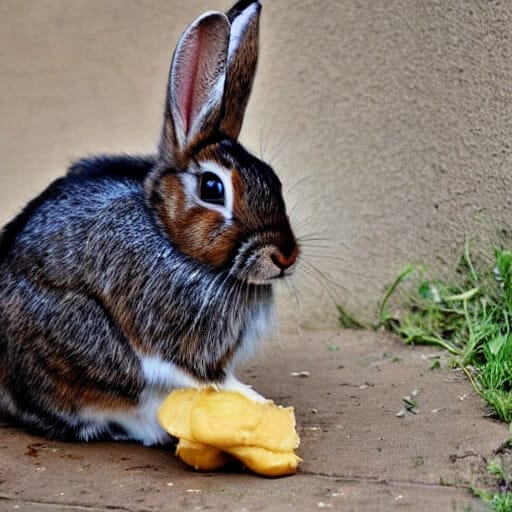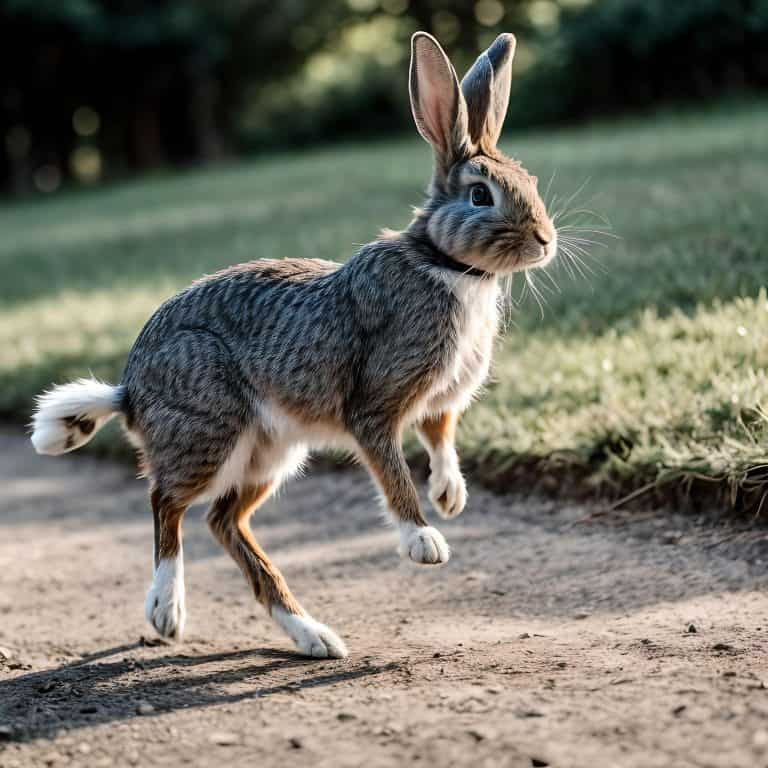Is a Rabbit a Primary Consumer? The Ultimate Guide to Understanding Rabbit Feeding Habits
A rabbit is considered a primary consumer as it eats autotrophs, such as grass, which are the primary producers. Rabbits are herbivores and do not eat other animals, only plants, making them a primary consumer in the food chain.
Understanding Primary Consumers
Rabbits are classified as primary consumers because they consume autotrophs, such as plants and grass. They are the first step up from the primary producers in the food chain.
The role of primary consumers in ecosystems is to consume autotrophs, which are the primary producers. Rabbits are considered primary consumers because they eat autotrophs such as grass. Primary consumers form the second trophic level in the food chain, with secondary consumers like birds of prey and foxes feeding on them. Unlike secondary consumers, primary consumers do not eat other consumers, only plants or other producers. The physical size of primary consumers can vary greatly, ranging from tiny zooplankton to elephants. Higher-level consumers, such as tertiary consumers, eat lower-level consumers and are sometimes known as final consumers. Humans, as omnivorous upper-level consumers, eat both plants and lower-level consumers. In conclusion, rabbits play an essential role as primary consumers in ecosystems by consuming autotrophs and serving as a food source for higher-level consumers.
Rabbit As A Primary Consumer
Rabbits are considered primary consumers as they eat autotrophs, like grass. They are the first step up from primary producers and are eaten by secondary consumers like birds of prey and foxes.
Rabbits are classified as primary consumers because they primarily feed on autotrophs, such as grass. Primary consumers are the first step up from the primary producers. They are herbivores that consume plants or other producers. Rabbits do not make their own food and rely on consuming other organisms for nutrition. They are an important link in the food chain as they serve as prey for secondary consumers like birds of prey and foxes. Rabbits have a diet that mainly consists of plant materials, including grass, leaves, and vegetables. Their feeding habits include grazing on grass and foraging for vegetation. The characteristics of rabbits as primary consumers highlight their role in maintaining the balance of ecosystems by promoting the growth of plants and providing energy for higher-level consumers.
Rabbit’s Position In The Food Chain
Rabbits are considered primary consumers in the food chain as they eat autotrophs like grass. They are the first step up from the primary producers. Secondary consumers, such as birds of prey and foxes, feed on rabbits as primary consumers.
Rabbit’s Position in the Food Chain Rabbits are classified as primary consumers in the food chain. They are the first step up from the primary producers, which are autotrophs that produce their own food. Primary consumers such as rabbits feed on autotrophs, mostly plants like grass. They play an important role as prey animals for secondary consumers like birds of prey and foxes. As primary consumers, rabbits do not make their own food and rely on other organisms for sustenance. They primarily feed on plants and occasionally consume other plant materials. Unlike secondary consumers, rabbits do not eat other animals. However, their role as primary consumers makes them a vital link in the food chain, supporting the population of secondary consumers that rely on them for sustenance. In summary, rabbits occupy the position of primary consumers in the food chain. Their diet consists mainly of plants, making them an essential part of the ecosystem as prey animals for higher-level consumers.
Impact Of Rabbits On Ecosystems
When it comes to the impact of rabbits on ecosystems, it is important to consider their influence on plant growth and vegetation. Rabbits are primary consumers, meaning they eat autotrophs such as grass, which makes them essential for maintaining the balance between rabbit populations and ecosystem health. Their feeding habits can promote vegetation growth by controlling the spread of certain plants and redistributing nutrients through their droppings. However, if rabbit populations become too large, they can overgraze and damage the vegetation, leading to a decrease in plant diversity and potentially impacting other species that depend on the vegetation for food and habitat. Rabbits’ role as primary consumers also has a domino effect on the rest of the ecosystem. They serve as a food source for secondary consumers such as birds of prey and foxes, regulating their populations as well. This interconnectedness highlights the importance of maintaining a balanced population of rabbits to ensure the overall health and sustainability of ecosystems.
Rabbit Vs Other Primary Consumers
A rabbit is classified as a primary consumer, as it feeds on autotrophs such as grass. Primary consumers are the first step up from the primary producers and are further consumed by secondary consumers like birds of prey and foxes.
| Comparison of Rabbits with Other Primary Consumers |
| Distinguishing Features |
| When it comes to primary consumers, one significant distinction is the feeding habits. While rabbits solely feed on plants, secondary consumers such as foxes eat primary consumers, including rabbits. |
| Another distinguishing feature is the trophic level. Rabbits, being herbivores, occupy the first trophic level as they consume producers like plants. On the other hand, secondary consumers like foxes occupy the second trophic level. |
| Comparative Examples |
| For instance, a rabbit as a primary consumer eats primary producers like grass. In contrast, a red fox, a secondary consumer, feeds on rabbits as its primary source of food. |
| In conclusion, rabbits possess unique characteristics as primary consumers, predominantly consuming plants at the first trophic level. However, they differ from secondary consumers, such as foxes, both in terms of their feeding habits and trophic level occupied. |
Potential Predators Of Rabbits
A rabbit is considered a primary consumer as it feeds on autotrophs like grass. However, it can also be preyed upon by secondary consumers such as birds of prey and foxes.
| Potential Predators of Rabbits |
|---|
| Natural predators of rabbits in the wild: |
| 1. Birds of prey |
| 2. Foxes |
| 3. Coyotes |
| 4. Wolves |
| 5. Bobcats |
Rabbits are primary consumers, meaning they feed on autotrophs such as grass. They are one step up from autotrophs, the primary producers. They are herbivores and rely on plant material as their main source of food. In the wild, rabbits face natural predators that prey on them for food. These predators include birds of prey, such as hawks and eagles, foxes, coyotes, wolves, and bobcats. These animals are secondary consumers as they feed on the primary consumers, which in this case are the rabbits. The relationship between predator-prey dynamics and primary consumers is essential for maintaining a balanced ecosystem. Predators help control the population of primary consumers, ensuring the stability of the food chain. Note: The above information is in HTML format using a table to present the list of potential predators of rabbits.
Human Interaction With Rabbit Populations
| Blog post title: | Is a Rabbit a Primary Consumer |
|---|---|
| Heading: | Human Interaction with Rabbit Populations |
| Subheading: | Human activities affecting rabbit populations |
In regard to rabbit populations, human activities can have both positive and negative impacts. Urbanization and habitat destruction, for example, can lead to a decline in rabbit populations as their natural habitats are destroyed. Additionally, the introduction of non-native predators can pose a threat to rabbit populations. On the other hand, there are various conservation efforts and management strategies in place to protect rabbits. These may include the creation of protected areas, habitat restoration projects, and efforts to control non-native predators. Overall, it is important to recognize the role of human activities in shaping rabbit populations and to implement measures that ensure their long-term survival.
Frequently Asked Questions On Is A Rabbit A Primary Consumer
Is A Rabbit A Primary And Secondary Consumer?
A rabbit is a primary consumer that eats plants, making it the first step up from autotrophs.
Is A Rabbit A Primary Secondary Or Tertiary?
A rabbit is a primary consumer, as it eats autotrophs such as grass, which are the primary producers.
What Is A Secondary Consumer To A Rabbit?
A rabbit is a primary consumer that eats autotrophs like grass. It is not a secondary consumer.
Is A Rabbit A Producer Or Consumer?
A rabbit is a primary consumer because it feeds on plants.
Conclusion
Rabbits are considered primary consumers as they feed on autotrophs, such as grass. Being the first step up from primary producers, rabbits play an important role in the food chain. They serve as a food source for secondary consumers, like birds of prey and foxes.
As a primary consumer, rabbits contribute to the balance of ecosystems and the overall biodiversity. Understanding the role of rabbits as primary consumers helps us appreciate their significance in the natural world.


